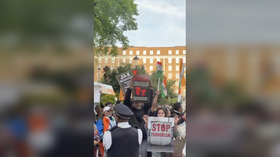Death toll from ‘mother of all bombs’ in Afghanistan rises to over 90 militants - Afghan officials

Afghan officials have reported a big rise in the death toll from America’s biggest non-nuclear bomb, nicknamed the ‘mother of all bombs’, announcing that the mega-bomb killed over 90 Islamic State fighters.
The GBU-43/B Massive Ordnance Air Blast Bomb (MOAB) was unleashed in combat for the first time on Thursday. The 21,000-pound (9,525 kg) bomb was dropped on a tunnel complex in the Achin district of the Nangarhar province in eastern Afghanistan near the Pakistani border. The area is said to be used by affiliates of Islamic State (IS, formerly ISIS/ISIL).
The MOAB, developed during the Iraq war, was never used after testing due to concerns that it could cause mass civilian casualties.
According to Ataullah Khogyani, spokesman for the governor of Nangarhar province, 94 militants were killed in the blast, including four commanders.
"Fortunately there is no report of civilians being killed in the attack," Khogyani told AP.
Earlier, Achin district’s governor Esmail Shinwari said 92 IS fighters had been killed. These death tolls are much higher than the initial figure of 36 IS fighters provided by Afghan officials.
Although the US Central Command noted that they “took every precaution to avoid civilian casualties with this strike,” the weapon’s documented force and the remote location of the blast has led some to question to what degree of accuracy the death toll could be tallied.
Sher Nabi, a commander with the Afghan Local Police, told the LA Times earlier this week that the bomb had landed about a half mile outside the town of Shogal near the border with Pakistan, and that “many militants” were killed.
Achin district’s governor told AFP that the explosion was “the biggest I have ever seen. Towering flames engulfed the area.”
An MP from Nangarhar, Esmatullah Shinwari, said locals had told him that a teacher and his young son were killed, the Guardian reports.
The New York Times cited a resident as saying that four houses in the Pekhe area about three miles from the blast were completely destroyed.
The Air Force developed the MOAB in 2003, but it had never been used in combat until Thursday. The US dropped the bomb as its involvement in Afghanistan will head into its 16th year this fall, and just days after Staff Sergeant Mark De Alencar, a US Special Forces operator, was killed in the same region.
President Donald Trump acknowledged that he had given the US military “total authorization” to drop the MOAB.
“It was really another successful job. We’re very, very proud of our military,” Trump said on Thursday, adding “we have the greatest military in the world, and they’ve done their job as usual.”
When asked if the MOAB’s deployment in Afghanistan was intended to send a message to North Korea amid increased tensions with the isolated country, Trump replied: “I don’t know if it sends a message, I don’t care if it does or not.”
Former Afghan President Hamid Karzai “vehemently” condemned the bombing in a series of tweets, describing it as “brutal misuse of our country,” while accusing the US of using Afghanistan as a “testing ground for new and dangerous weapons.”
Some experts have called the move ineffective.
“The Trump administration made a lot of noise with this bomb, but the general state of play on the ground remains the same: The Taliban continues to wage a formidable and ferocious insurgency. ISIS, by comparison, is a sideshow,” Michael Kugelman of the Woodrow Wilson Center in Washington told AFP.
“Still, from a strategic standpoint, there is an unsettling takeaway here: The US pulled off a huge shock and awe mission against an enemy that isn’t even the top threat to the US in Afghanistan. The Taliban continues to sit pretty,” he added.
The bombing came only a week after the US carried out a missile strike on the Shayrat Airfield near Homs, Syria, in response to an alleged chemical attack on a rebel-held town in Idlib province, the blame for which Washington pinned on the Assad government. A total of 59 Tomahawk missiles were deployed in the pre-dawn US attack ordered by Trump. Washington has yet to present any fact-based evidence to confirm its allegations against the Syrian military.
Although its presence in Afghanistan is smaller than that of the country’s main insurgent group, the Taliban; IS’s local branch – the Islamic State of Iraq and the Levant – in Khorasan Province (ISIL-K) numbers some 600-800 fighters, US officials say.













